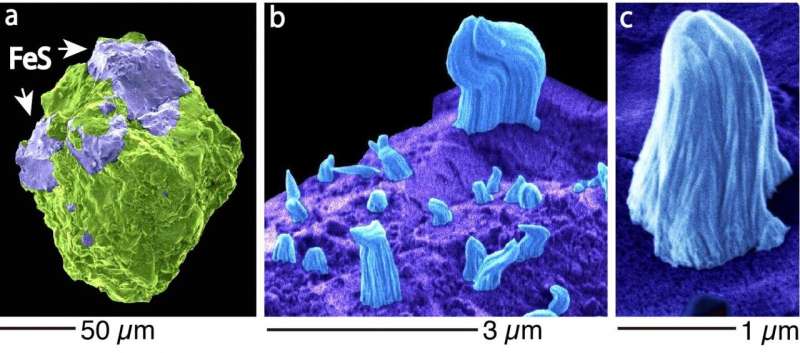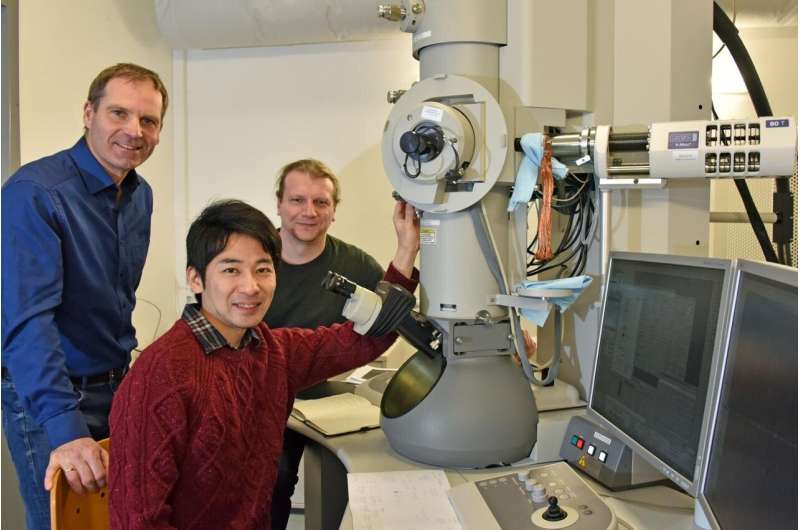An iron-clad asteroid

Itokawa would normally be a fairly average near-Earth asteroid—a rocky mass measuring only a few hundred metres in diameter, which orbits the sun amid countless other celestial bodies and repeatedly crosses the orbit of the Earth. But there is one fact that sets Itokawa apart: in 2005 it hosted a visit from Earth. The Japanese space agency JAXA sent the Hayabusa probe to Itokawa, which collected soil samples and brought them safely back to Earth—for the first time in the history of space travel. This valuable cargo arrived in 2010 and since then, the samples have been the subject of intensive research.
A team from Japan and Jena has now succeeded in coaxing a previously undiscovered secret from some of these tiny sample particles: the surface of the dust grains is covered with tiny wafer-thin crystals of iron. This observation surprised Prof. Falko Langenhorst and Dr. Dennis Harries of Friedrich Schiller University in Jena. After all, over the last 10 years, research teams all over the world have exhaustively studied the structure and chemical composition of the dust particles from Itokawa, and no one had noticed the iron 'whiskers.' It was only when Japanese researcher Dr. Toru Matsumoto, who is spending a year as a visiting scientist with the Analytical Mineralogy group at the Institute of Geosciences in Jena, examined the particles with a transmission electron microscope that he was able to locate the crystals using high-resolution images.
Solar wind weathers celestial bodies
This discovery is exciting not only because the tiny iron 'whiskers'—which have since been shown on other particles from the asteroid as well—had previously been missed. Of particular interest is how they were formed. "These structures are the consequence of cosmic influences on the surface of the asteroid," explains Falko Langenhorst. In addition to rocks, high-energy particles from the solar wind also strike the asteroid's surface, thus weathering it. An important constituent of the asteroid is the mineral troilite, in which iron and sulphur are bound. "As a result of space weathering, the iron is released from the troilite and deposited on the surface in the form of the needles that have now been discovered," says the mineralogist Langenhorst. The sulphur from the iron sulphide then evaporates into the surrounding vacuum in the form of gaseous sulphur compounds.

From the size and number of the ice crystals detected, the researchers can also estimate how quickly the asteroid loses sulphur. "The process is incredibly fast from a cosmic perspective," explains Toru Matsumoto. The crystals he analysed are up to two-and-a-half micrometres long, which is around one-fiftieth of the thickness of a human hair. "The tiny whiskers have already reached these sizes after around 1,000 years," adds the researcher from Kyushu University in Fukuoka. Over the long term, the analysis of the ice crystals can be used to gain a better understanding of weathering processes on other celestial bodies as well, and to determine their age.
To this end, the researchers already have specific asteroids in their sights. NASA's OSIRIS-REx probe is currently preparing to take samples from asteroid Bennu, while JAXA's Hayabusa2 is already on its way back to Earth. The Japanese probe visited the Ryugu asteroid last year and, as with Itokawa, it collected dust particles. The samples should land on Earth at the end of 2020 and the international team of Jena mineralogists and Toru Matsumoto are awaiting them with anticipation.
More information: Toru Matsumoto et al, Iron whiskers on asteroid Itokawa indicate sulfide destruction by space weathering, Nature Communications (2020). DOI: 10.1038/s41467-020-14758-3
Journal information: Nature Communications
Provided by Friedrich Schiller University of Jena



















